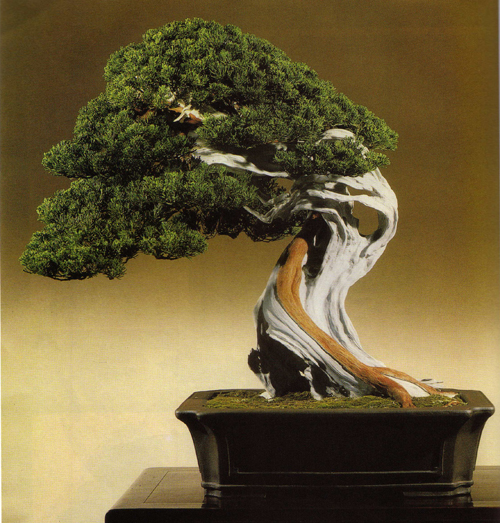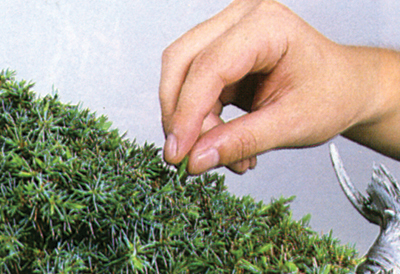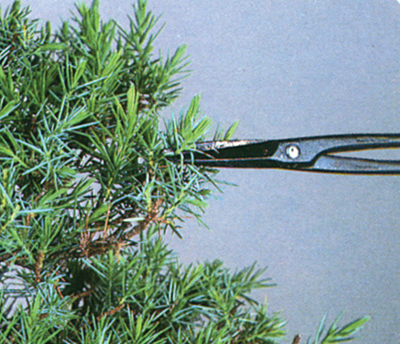
Even if you’re one of those curmudgeons who complains about the overly sculpted look of some Japanese bonsai, you’ve got to admit that this powerhouse Shimpaku approaches perfection. That trunk draws your eye like few trunks anywhere, with its single living vein, mysterious hollow at its base and the spidery fingers and hole at the top. But it’s the tight lush foliage that I want to point out here; the result of some serious trimming and pinching. The photo is from our Juniper book. Artist unknown.
A question about pinching on Michael Hagedorn’s site
The following is from the Seasonal section of Crataegus Bonsai (Michael’s site). It starts with a question by Ron Verna: I have a shimpaku juniper that I’m concerned about it has lost a lot of foliage and doesn’t look as bushy as I would like. Would piching and repotting help?
Michael’s reply
Hello Ron, Although it is difficult to advise without seeing an image, in general, we pinch far too much on junipers. I recommend cutting the longer shoots that push out of a foliage pad with a scissors, a couple times a year, rather than trying to create density with pinching. That tends to greatly weaken junipers. Repotting can rejuvenate a tree that is metabolically slowing down because the pot is full of roots.

You can pinch with your fingers (but not too much!), and….

…you can also use the tips of your shears for fine trimming.

Thinning: before and after. From our Juniper book.
Wayne,
Michael makes a good point. I once had the good fortune of having a juniper initially styled by Hiromi Tsukada at a demonstration held at Shanti Bithi Nursery in Conn. At one point, I had to leave the greenhouse because I couldn’t believe the vast amount of foliage that he removed to reveal the elegant branch structure of the 40 y/o pre-bonsai I had brought. It was actually kind of “painful” to watch. Through translation it was explained to me that the juniper would eventually fill out with time and that in order to keep it healthy and well-styled I should maintain the open airy quality of the original design. Since then, I have opened up the canopy (or crown) of all of my junipers through judicious pruning (as well as some pinching) to permit healthy growth, reduce die back and essentially keep my trees looking like bonsai rather than “bushes.” Great article as usual!
Owen
Thanks Owen,
There’s good reason to remove foliage when you transplant. Less foliage for the compromised roots to support. But I think we might be talking about two different things. Michael says don’t pinch too much foliage off one spot on an established tree, you can weaken that part of the tree if you do. Or even the whole tree if you do too much pinching throughout. However, thinning by removing whole branches is a little different; you still leave enough strong foliage on the remaining branches to keep them strong.
Wayne,
Perhaps the issue is the term “pinching” which would crush the new growth tips. When working with Craig Coussins and Suthin they both called it “plucking” – and said to pull the foliage off. I find it best to hold what I don’t want plucked off with my other hand and then pull off what has grown to strong. It prevents more foliage from being removed than you planned on. Using scissors cuts through several layers of growth, leaving brown tips. Pinching, plucking or cutting back to far can weaken the foliage pads, but letting them get too long results in interior browning as the growth extends and matures.
Hi Ken,
Good point. Plucking. I think that’s what some people do and just call it pinching. But, for sure there is a difference.